Ikkyo Complete 6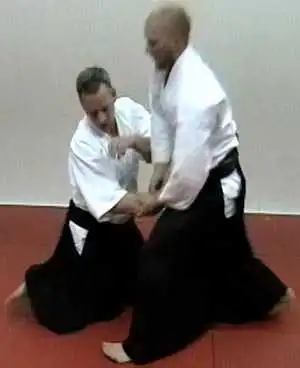 Hanmi handachiwaza — Seated defense against standing attackerHanmi HandachiwazaHanmi handachiwaza, where tori is sitting and uke standing, is good exercise in doing aikido techniques on people much taller than yourself. There's one basic principle for how to do it: bring uke down to your level. Start by this, and the rest of the technique should not be more difficult than if you were standing, too.
Hanmi handachiwaza
Hanmi handachiwaza ikkyo, omote and ura, on all the attack forms explained below. Many more aikido videos on my YouTube Channel.
It is quite easy in jutai, when you start before uke's grip is completed. In gotai, from a static position, it is very important that you start pulling in the direction of uke's attack. If you try to go down at once, uke can easily resist. Make sure to make the downward curve all the way to the floor, or uke will not be brought down sufficiently. When you continue with the ikkyo movement, don't allow uke to stand up again, or you will get stuck somewhere in the middle of it. When you have brought uke down, keep uke there all through the technique. If you do it well, your initial move will turn hanmi handachiwaza pretty much into suwariwaza. Like always on ikkyo, ura starts the same way as omote. Only after you have both your hands on uke's arm, do you choose omote or ura. Both omote and ura are on the video clip.
Ryotedori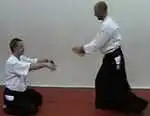 Ryotedori is done the same way as gyakuhanmi katatedori, which is why only the former is included here.
Ryotedori is done the same way as gyakuhanmi katatedori, which is why only the former is included here.You bring uke down by pushing on uke's elbow — not higher or lower on the arm than that, to make sure that uke gets stuck in your push. This push is possible if you extend uke's arm forward at first, which is the direction of the attack and therefore meets with no resistance from uke. When uke is extended forward, the downward push needs little force. Do it in the spirit of lowering your arm to your center. Push uke's elbow almost all the way to the floor, so that the rest gets similar to suwariwaza. If you press the elbow onto the floor, uke tends to fall to the side — which is fun, but not practical when you want to do ikkyo after that. Don't worry about uke's grip on your other wrist — it will be released during the course of the technique, without any effort. Both omote and ura are on the video clip.
Morotedori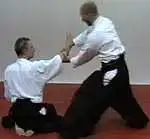 Many in aikido do morotedori from the front, which is not practical for uke — locking both arms while only one of tori's arms is locked. In tachiwaza, when both are standing up, the best for uke is to hold morotedori almost behind tori, but that is not possible to do in hanmi handachiwaza. Instead, morotedori should be done from the side.
Many in aikido do morotedori from the front, which is not practical for uke — locking both arms while only one of tori's arms is locked. In tachiwaza, when both are standing up, the best for uke is to hold morotedori almost behind tori, but that is not possible to do in hanmi handachiwaza. Instead, morotedori should be done from the side.To bring uke down, turn your elbow in a curve down and in, toward your own body. This is a very powerful move, hard for anyone to resist. Still, try to do it so that uke is extended forward, in the direction of the attack. This helps a lot in taking away uke's ability to resist. The hand you do the ikkyo on, is the same as in gyakuhanmi katatedori (uke's left if your right arm is grabbed, and uke's right if your left arm is grabbed). The other hand is no problem — its grip will be released when you do the upward turn of the ikkyo. On this video clip, the technique is shown in gotai, from a static position. In jutai you start before the grip is completed, which is very easy and therefore not necessary to show on video. Both omote and ura are on the video clip.
Ryokatadori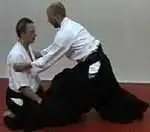 Ryokatadori is done in the same way as katadori, which is why only the former is shown here. For comparison, I have made video clips of both gotai, from a static position, and jutai, starting before uke's attack is completed. The link above leads to the gotai version, and the link below to jutai.
Ryokatadori is done in the same way as katadori, which is why only the former is shown here. For comparison, I have made video clips of both gotai, from a static position, and jutai, starting before uke's attack is completed. The link above leads to the gotai version, and the link below to jutai.You bring uke down by pushing down uke's elbow, just like in ryotedori. Make sure to extend uke forward at first. That you do in your taisabaki turn in the beginning, pulling at one of the shoulder grips. Make sure to make the downward push at the elbow, neither below nor above it on uke's arm. Otherwise it's easy for uke to resist. Push almost to the floor, but not all the way, or the rest of the ikkyo will be difficult. You release the shoulder grips by pushing uke's arm upward, and by turning your body for the ikkyo. It should not be a problem, but you might need to push uke's arm forcefully upward for that arm's grip to be released. Make sure to do it with help of your whole body movement. Both omote and ura are on the video clip. Here is the same technique in jutai, starting before uke's attack is completed: Ryokatadori — jutai
Shomenuchi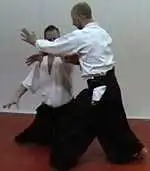 In the striking attacks, uke has a great advantage when tori is sitting down. It's significantly more difficult to do the aikido techniques convincingly in hanmi handachiwaza than in tachiwaza or suwariwaza. You really have to get out of the way of the attack.
In the striking attacks, uke has a great advantage when tori is sitting down. It's significantly more difficult to do the aikido techniques convincingly in hanmi handachiwaza than in tachiwaza or suwariwaza. You really have to get out of the way of the attack.When doing so, make your taisabaki turn a full 90°. That way you are centered and in good balance, when you need to bring uke down. This you do by pushing uke's arm down by the elbow. On the video clip I first make an ukenagashi style parry, and then bring my hand around for the downward push. You could skip the former, and go directly for the downward push, but then you have less control of uke's arm. Make sure that uke doesn't get up again, when you continue with the ikkyo technique. As in most hanmi handachiwaza techniques, the best is if you get uke down so much that it becomes like suwariwaza. In ura, it's important that you start like omote, or it will be very difficult to get uke's arm in the position needed for ikkyo. Both omote and ura are on the video clip.
Yokomenuchi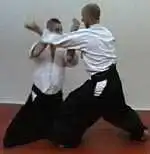 Yokomenuchi is treated similar to for example gyakuhanmi katatedori and katadori. With one arm you extend uke forward, with the other you do an atemi move to uke's face. Make sure to turn a full 90° before your arms do this, so that you are centered and balanced. Also, you should advance so much that uke's hand would not hit you, even if you were not blocking it.
Yokomenuchi is treated similar to for example gyakuhanmi katatedori and katadori. With one arm you extend uke forward, with the other you do an atemi move to uke's face. Make sure to turn a full 90° before your arms do this, so that you are centered and balanced. Also, you should advance so much that uke's hand would not hit you, even if you were not blocking it.Next, you bring uke down by pushing by uke's elbow. Don't let uke get up again. Ura starts on the omote side, or you will have great trouble leading uke's arm into position for ikkyo. When you have brought uke down, and start to raise uke's arm for the ikkyo, that's when you choose omote or ura. Both omote and ura are on the video clip.
Jodan tsuki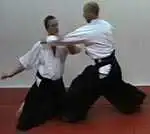 Uke is not likely to try a tsuki lower than jodan, because you are such a low target sitting down. It's a powerful angle of attack, so you really need to get out of line of it. Use your arm and your body turn to extend uke's tsuki forward as much as you can, to make sure that uke gets out of balance and is brought down. At that point, you should be facing the same direction as uke is.
Uke is not likely to try a tsuki lower than jodan, because you are such a low target sitting down. It's a powerful angle of attack, so you really need to get out of line of it. Use your arm and your body turn to extend uke's tsuki forward as much as you can, to make sure that uke gets out of balance and is brought down. At that point, you should be facing the same direction as uke is.In most aikido techniques against tsuki, it's important to get in contact with uke's arm and pull or push it, before the tsuki is completed. If later, uke is difficult to get out of balance. Also, uke might immediately withdraw the arm. When your hand grabs uke's arm, it should be done with a movement in the same direction as uke's tsuki. Don't try to block or redirect it. Ura must start like omote, or it will be very difficult to get uke's arm in position for the ikkyo. Only after you have extended uke's tsuki, and brought uke down in this movement, do you choose omote or ura. Both omote and ura are on the video clip.
Ushiro ryokatadori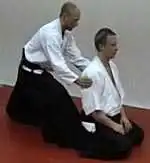 On the video clip, the technique is done from gotai, a static position, for clarity. In jutai, uke usually starts the attack from in front of you, moving around to your rear.
On the video clip, the technique is done from gotai, a static position, for clarity. In jutai, uke usually starts the attack from in front of you, moving around to your rear.You need to pull uke forward, by using a circular shoulder and arm movement, and by your taisabaki move forward and to the side. While uke is still moving forward from this pull, you sneak backward, under uke's arm. Then you should hurry to block uke's arm by extending yours, or uke can attack with the elbow. By extending your arm you also release the katadori grip on that shoulder. The grip on your other shoulder is released mainly by your body movement. Ura starts the same way as omote. Only after you are released from both shoulder grips, do you decide on omote or ura. If you try to initiate the ura turn before being free from both of the shoulder grips, you can get really stuck. Both omote and ura are on the video clip.
Ushiro eridori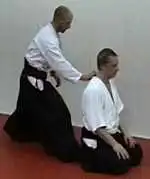 Ikkyo on eridori is done quite the same in hanmi handachiwaza and tachiwaza. You have a slight advantage in hanmi handachiwaza, since you don't have do lower yourself additionally to get under uke's arm. On the other hand, it is a little more difficult to get uke moving by your own turning in the beginning.
Ikkyo on eridori is done quite the same in hanmi handachiwaza and tachiwaza. You have a slight advantage in hanmi handachiwaza, since you don't have do lower yourself additionally to get under uke's arm. On the other hand, it is a little more difficult to get uke moving by your own turning in the beginning.The collar grip is released when you push uke's arm upward. Don't continue with the ikkyo before uke has lost the collar grip, or you can get yourself stuck. Ura starts the same way as omote. It's at the moment when the collar grip is released, that you choose omote or ura. Both omote and ura are on the video clip.
Stefan Stenudd
IKKYO COMPLETE
AIKIDO PRACTICEIntroductionAikido Techniques — all the basic movesAttacks in Aikido
Tantodori — knife defenseAikiken — aikido sword techniquesJo 31 Kata in four directionsAikibatto sword and staff exercisesAiki — joining energiesKi exercisesAikido Video ClipsAikido PhotosMy aikido dojo in Malmö, SwedenMy aikido seminarsAIKIDO THEORYMy Aikido BioAikido GlossaryTanden, the CenterAikido InksAikido as Self-DefenseRunning a DojoAikido is TrueOsensei and EinsteinAikiWeb ColumnsAikido Books ReviewedDie deutsche Version meines Aikido-Buches onlineAikido på svenskaAbout CookiesMy Other WebsitesCREATION MYTHSMyths in general and myths of creation in particular.
TAOISMThe wisdom of Taoism and the Tao Te Ching, its ancient source.
LIFE ENERGYAn encyclopedia of life energy concepts around the world.
QI ENERGY EXERCISESQi (also spelled chi or ki) explained, with exercises to increase it.
I CHINGThe ancient Chinese system of divination and free online reading.
TAROTTarot card meanings in divination and a free online spread.
ASTROLOGYThe complete horoscope chart and how to read it.
MY AMAZON PAGE
MY YOUTUBE AIKIDO
MY YOUTUBE ART
MY FACEBOOK
MY INSTAGRAM
MY TWITTER
STENUDD PÅ SVENSKA
|
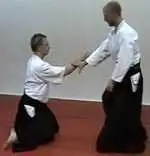
 Aikido Principles
Aikido Principles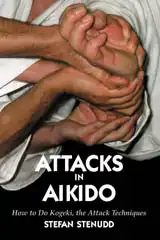 Attacks in Aikido
Attacks in Aikido Aikibatto
Aikibatto
